OK, so I’ve acquired too many lenses, both modern and legacy ones, in the last months or so since I bought my A7S2. At least if there is such a thing as owning too many lenses.
Too many at least means I haven’t had the time to try out as much as I’ve wanted.
So I thought I do a simple shootout at 35mm to start to get a better understanding of what I could expect from them.
Nothing fancy and too scientific, just something to learn a little bit more.
The lenses
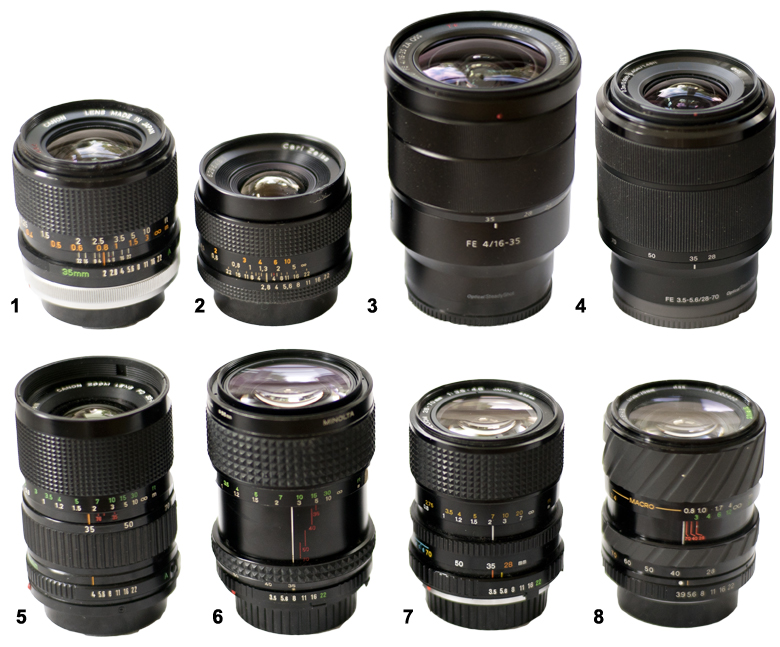
Most of the lenses are zooms of varying reputation and brands, but there are two well respected legacy primes too. Of the zooms there are four legacy ones and two contemporary Sonys.
1. Canon FD 35mm f2.0 S.S.C II
Released in April 1976 this is the second incarnation of the the original breech lock design and the last before the new FD series. It has a convex front element as opposed to the concave front element of the first version. The radioactive thorium element from the first version is also missing.
Internet lens-lore has this as inferior to the first concave version but still rates it as pretty good. Well, we will see how it stands the test of time.
It’s built like a tank and and is almost to heavy but got a nice and hefty feel.
2. Zeiss Contax 35mm f2.8
Made by Zeiss for the Contax SLRs from 1975 to 2005. Second-hand Zeiss Contax lenses still cost a fair amount but this is one of the least expensive and can be found for around $200 on eBay.
Well built and very small in size and weight this lens has a lot going for it. Fits in any camera bag.
3. Sony Vario-Tessar T* FE 16-35mm f4
If you want to go super wide with a native lens on a Sony full frame this is your main option. The reputation has it that this zoom is sharp from 16-24mm and weaker on the 35mm side.
Nice build quality and but size and weight is the tradeoff for having zoom convenience and autofocus.
4. Sony FE 28-70mm f3.5-5.6
This is the kit zoom that usually comes with the A7 bodies. Mine did.
A lot of plastics and but it feels OK and is very light.
5. Canon nFD 35-70mm f4
This can be got for almost nothing. I paid $30 for mine. Build quality is perhaps questionable with a lot of plastics, not like the old FD series with breachlock. But it’s fairly small and light.
6. MD Rokkor 35-70mm f3.5
A lot has been written about this lens since it’s one of the result of the Lecia-Minolta collaboration in the 70’s. This is said to be the same lens as the Vario-Elmar-R 35-70mm f/3.5.
There are three versions of this zoom, where the optic design is said to be different in the first compared with the second and third. The second dropped Rokkor from the name plate and the third included a macro option.
It’s the first version that gets tested here.
7. MD Zoom 28-70mm f3.5-4.5
Small and very light, this lens has a good feel to it. Not as famous as the MD Rokkor 35-70mm but it has a better zoom range and a semi-macro mode.
8. Sirius 28-70mm f3.9-4.8
Got this for $12 from an auction site. It’s from the 70’s and was also sold under the Tokina and Soligor brand. It’s easy to identify by it’s somewhat unusual aperture designation. Except from that I don’t know much about it. Could be a hidden gem though I somehow doubt it.
The shootout
The shootout was simple. I setup a tripod in my kitchen and took a series of pictures with every lens over the whole aperture range, testing for sharpness and what else I could find. Distance was about 3 to 4 meters. On top of that I also took a few pictures of my garden to get a better feeling for color rendition, contrast and focusing on larger distances
The A7S2 only has a 12 megapixel sensor so some of these lenses should outperform the sensor at least in the center. But given that transfer function of a camera system is the multiplication of each part (lens, sensor etc) there is no disadvantage using a better lens. A better lens will always make the the whole system better disregarding the resolution of the sensor.
I shot i RAW and opened them in Photoshop with Camera Raw 6.7. No additional processing or sharpening were done before saving the crops i maximum quality jpegs.
100% crops are marked in red in the picture above.
f2
At f2 there is only the Canon 35mm. The center and border is surprisingly sharp for being fully open. Even the corner is good considering the aperture. Vignetting is visible and the contrast is suffering a bit.
f2.8
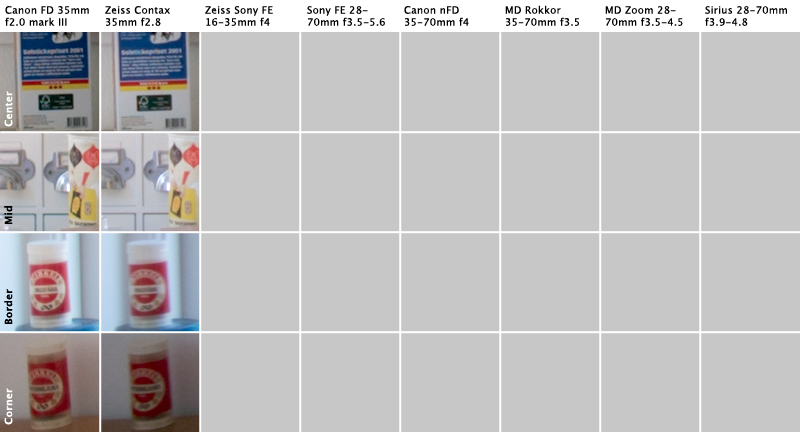
At 2.8 the Canon sharpens a little over the whole frame. The Contax Zeiss is as sharp with better contrast in the centre but trails behind by the border and in the corner.
f4
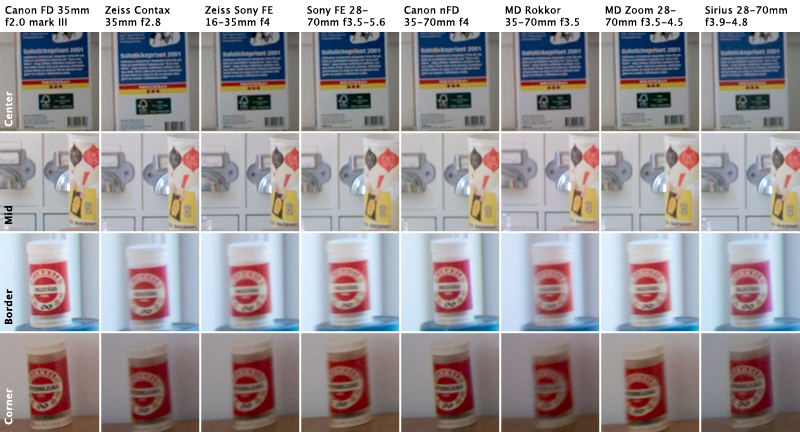
Now the rest of the lenses join in. In the center they are all almost as sharp with the exception of the Sirius that trails behind a little. I think the Contax Zeiss still has the upper hand with best contrast and color rendering in the center.
In the border and corners the situation is very different. Non except the Canon nFD 35-70mm comes close in sharpness to the Canon 35mm at f2, not to mention at f4.
Worst is the MD Rokkor 35-70mm.
f5.6
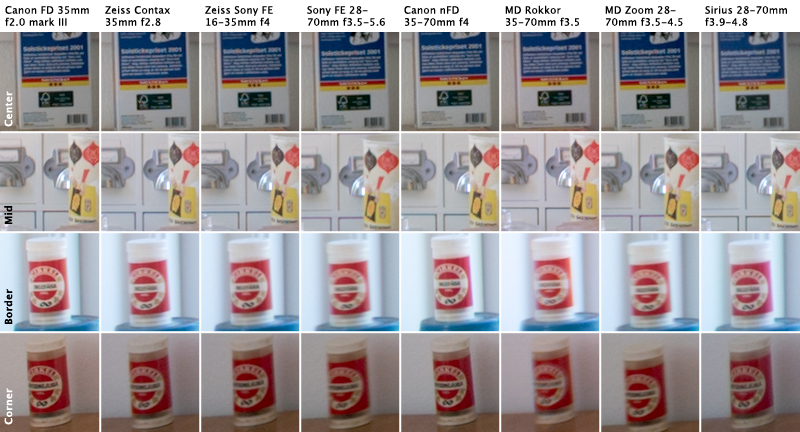
The Canon 35mm is now very sharp all over the frame even in the corners. The Zeiss Sony 16-35mm is starting to look better. The Sony 28-70mm has still a bit to go in sharpness in the border and corner. The Canon zoom is performing great as it’s almost as sharp as the Canon prime. The Sirius is performing better than expected.
The MD Rokkor 35-50mm is still the worst.
f8
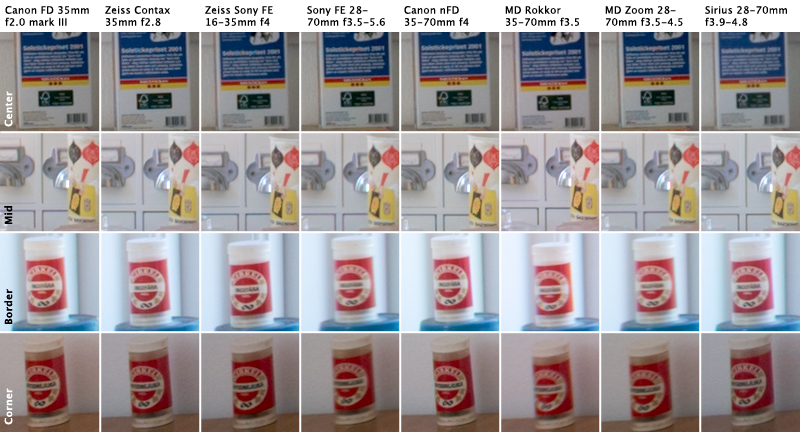
At f8 the Contax Zeiss is suddenly ahead of of the rest. Really good sharpness, contrast and colors all over the frame.
At this aperture you would expect a good lens, even a zoom to, perform well. In this case both the Minolta zooms and the Sony 28-70 disappoints. They aren’t sharp by the border or in the corner.
f11
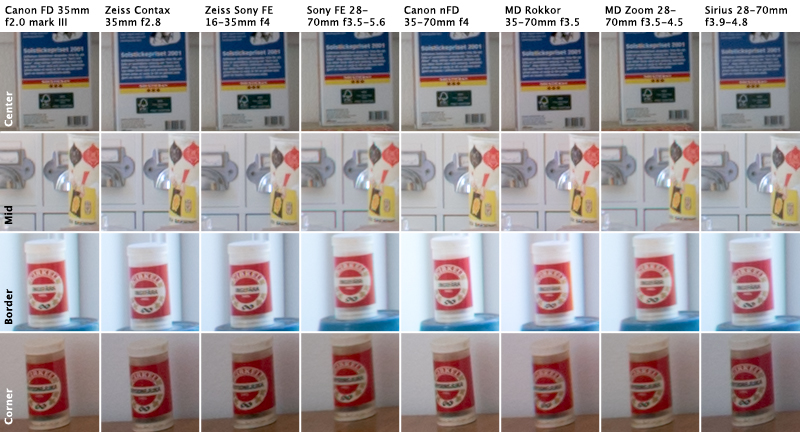
Diffraction is starting to show. The Sony 28-70mm and Minolta 35-70 are still struggling with corner sharpness.
f16
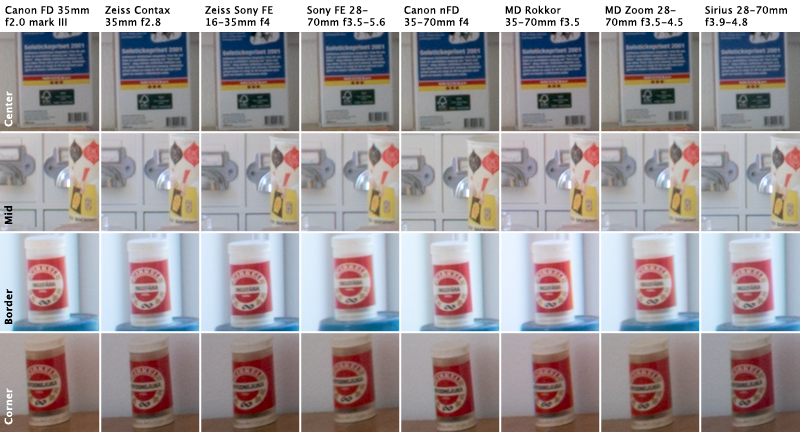
Still more diffraction. Not much difference between the lenses anymore.
My reflections and conclusions
1.Canon FD 35mm f2.0 S.S.C II
A very nice lens without any real cons. A little less contrast, vignetting and corner sharpness at f2.0. But it’s still better fully open than any of the other lenses at f4.
From f4 it’s sharp all over the frame and peaks at f5.6.
If you need a fast 35 to use at large apertures this is an excellent choice.
2. Zeiss Contax 25mm f2.8
This lens is a very mixed bag. Center sharpness and contrast is good across the range but the corners disappoint a lot on larger apertures. You really need to stop down to f8 to make it shine. But then it really, really shines with the best sharpness, contrast and color rendering of all the lenses here in my opinion.
For landscapes on a tripod and f8 this would be my choice.
3. Sony Vario-Tessar T* FE 16-35mm f4
This test just confirms other’s findings. 35mm is not the strongest part of it’s zoom range. It only gets real sharp by the borders and in corners at f8 and at f11 diffraction starts. For landscapes or other situations when overall sharpness is important I would only use this lens at f8 at 35mm.
It has a premium price and at 35mm it’s not the best value. But then you shouldn’t buy this lens for the long end of the range (I didn’t), but rather for it’s performance between 16 and 28 mm where it is really good.
4. Sony FE 28-70mm f3.5-5.6
Yes it is a kit lens.If it was a cheap kit lens, I would say it performs OK. It never gets really sharp by the border and in the corner. Of all the lenses here only the MD Rokkor 35-70mm performs worse. I’ve used it a bit and at 70mm it’s even worse regarding contrast and sharpness. Included on an A7 body for a minimal extra charge it can come to use as a first lens since it has autofocus and an useful range, but at full price ($500) it’s not a particular good value.
5. Canon nFD 35-70mm f4
This must be one of the best bargains on the vintage lens market. Overall performance at 35mm is really good starting at f4 with good sharpness and contrast even in the corners.
The only real weakness is the strong barrel distortion at 35mm and a bit to much chromatic aberration . If that doesn’t bother you you can get a small, light, well performing lens for almost nothing.
6. MD Rokkor 35-70mm f3.5
Despite the reputation of the Leica-Minolta collaboration and also being branded under the Leica label this is, by large, the worst performing lens in this test. Corners are very soft and with low contrast wide open. Stopping down, they get better but never good. Even the center sharpness is not really that good.
It’s said that the second and third version has a different optical formula that performs better.
7. MD Zoom 28-70mm f3.5-4.5
I like this lens very much despite it that performs about average in this test (but still much better that it’s 35-70mm sibling). But what it lacks in optical prowess it compensates with size, weight, rendering and a useful semi-macro mode. It makes a really nice APS-C normal to short tele zoom. It balances nicely on my NEX-7 and at $30 (what I paid) it’s well worth the money.
8. Sirius 28-70mm f3.9-4.8
For the $12 I paid it’s not a bad lens. It actually has better sharpness that the $500 Sony 28-70mm. The real weakness is a lot of chromatic aberration.
Still a lens that can be put to good use if your budget is really tight.
Last word
As I’ve said earlier, I made this little test to try to get to know my lenses a little better. There is so much more than this to fully evaluate a lens and it’s usefulness. Remember, I mainly shoot landscapes and nature, so my opinions and conclusions are bias towards that. And for the zooms this is only for one part of their range. They can perform better or worse at the other end of the range. Except from the MD Rokkor 35-70mm, which I think is not a good lens, all these lenses can be put to good use at 35mm if you consider their strengths, weaknesses and price and use them in the right way.

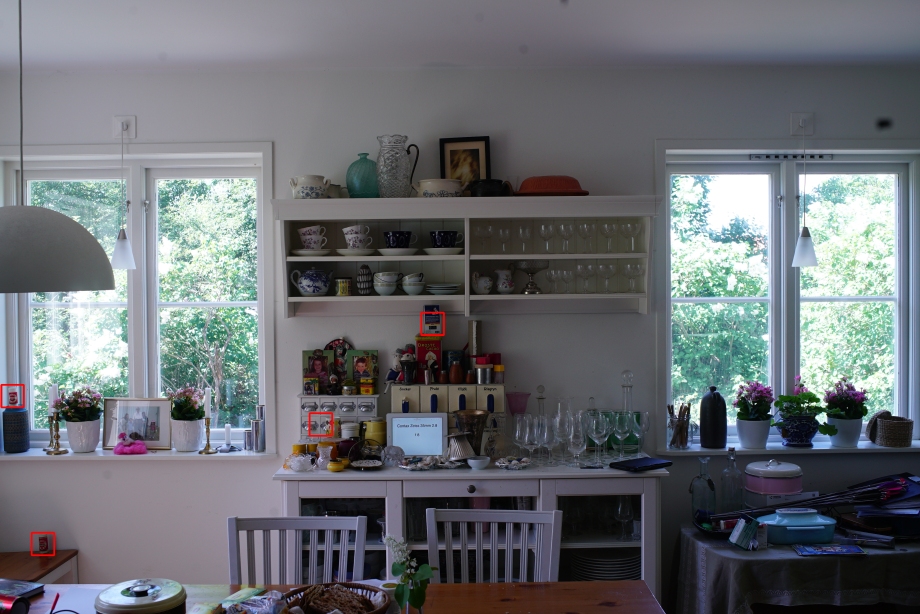
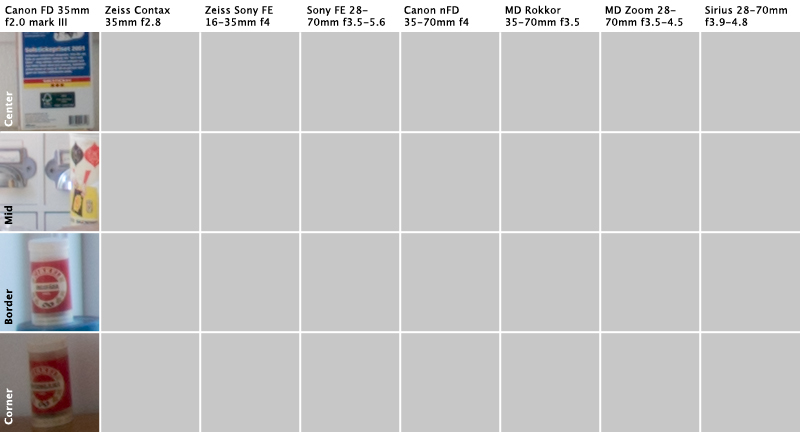
I’m curious if the newer formulas of the Minolta 35-70m are that much better? I tested mien against the well-respected Zeiss C/Y 35-70mm and they were hard to head.
And then, which version of the Zeiss C/Y 35mm did you test, the AE or the MM? My MM is pretty good even at wieder apertures.
LikeLike
Mine is an AE. So there could be a difference in the formula even thought I haven’t found anything on that.
It gets very mixed opinions on corner sharpness wide open, some say it’s great and som differ including Zeiss own specs I think (ca be found here for the MM version http://www.zeiss.com/content/dam/Photography/new/pdf/en/downloadcenter/contax_yashica/distagon2-8_35mm_e.pdf).
But at f8 there is not many lenses that compare on sharpness and perhaps more important contrast and color rendering. It’s a keeper for me because of that.
Could be my sample of the Rokkor was bad. I’ve also got the Contax Zeiss 35-70mm and it is much better in all departments. The lens that is on the camera most of the time actually.
Can’t compare them since I’ve sold the Rokkor.
LikeLike
The MD Rokkor 35-70mm f3.5 type III (the latest) macro is much better than the previous versions according to my (and others) tests on A7. Almost as sharp at 35mm as FD 35 f2.0 S.S.C concave, FD 35 f2.0 S.S.C convex and FDn 35 f2.0 from f4.0 and upwards. So, forget the test results for the older versions. I doubt the MD Rokkor 28-70 f3.5-4.5 is better giving the same focal length and aperture. The build quality of old Minolta (MC/MD) is superior to most Canon FDn.
LikeLike
[…] (ALC). An unpretentious test of 35mm on 8 lenses on A7S2. Primes and zoom, some Sony some legacy (Scatteredlightblog). Sony a6500 touch autofocus skate park test – graded with Filmconvert […]
LikeLike
Nice article. 35mm is many photographers’ favorite Lens. In that endless search for the optimal model, I went through the same Canon FD as yours, but eventually sold it out after a couple of months. The overall sharpness was disappointing to me (on Sony A7II). Its substitute is the Voigtlander Ultron 35mm f1.7 and it seems that a love story has just begun. I love its image rendering, pin sharp from 1.7. Lots of vignetting but very well corrected in LR. Only the handling with a thin focus ring is questionable.
LikeLiked by 1 person
I’ve spent (some might say far too many) years looking at similar things regarding system (lenses + cameras) resolution .
[ http://photosketchpad.blogspot.com/ – look down the right side under “Resolution in Photography” ]
One of the things I’ve only fairly recently learned the full importance of is field curvature. When you do these kinds of comparisons on 2D (flat) scenes, lenses that curve will show resolution drop-offs in the corners. Yet, many times when field curvature is taken into account, the corners can actually be quite sharp.
A case in point that might be relevant here – I performed a comparison between a Sigma 19mm f/2.8 EX DN E and Sony’s 16mm f/2.8 SEL [ http://photosketchpad.blogspot.fr/2015/02/sony-a6000-sony-16mm-f28-e-sigma-19mm.html ]. At first look the Sony 16mm is horrible in the corners are all apertures. But when focusing in the corners I found the edges cleaned up fairly nicely [ http://photosketchpad.blogspot.fr/2015/12/sony-sel-kit-18-55mm-sony-sel-16mm-f28.html ].
I’ve seen similar things with cheap kit lenses. Seldom are the edges as awful as one sees on 2D subjects. Because I have other lenses that offer consistent optical performance I vacillate over using that horrid 18-55mm Sony SEL OSS. But I’ve found part of what’s going on with the kit lens is that in addition to all the other optical distortions ( barrel/pincushion, chromatic aberrations, etc) there is a fair amount of field curvature.
Having said all this, I find it amazing that modern optical designs allow for inexpensive high resolution flat field lenses, such as what I’ve found in Sigma’s Art DN. Back when dinosaurs roamed the earth it used to be that only “macro” lenses had fairly flat fields.
LikeLiked by 1 person
I agree, field curvature plays a big part and is not taken in consideration. I found this out in another test on the MD Rokkor 24/2.8. https://scatteredlightblog.wordpress.com/2016/04/28/w-rokkor-md-24mm-f2-8-vs-sony-zeiss-16-35mm-f4-on-sony-a7s-ii/
Could be that this is the reason for the Contax Zeiss bad corner performance, but I haven’t tested or confirmed this.
LikeLike
I really wonder if the performance would have been different on longer distances. I mean, 3m from a wall is not exactly the same as 10 m or infinity. I understand that it is convenient to test indoors, but is it really that relevant for landscape or cityscape shooters?
LikeLiked by 1 person
To your question of how performance changes with distance, the Great Yellow Father (Kodak) used to suggest comparing lens performance at 10 to 1 distance to focal length. They suggested this for consistency sake. And, yes, that was doing the time of simple lens formulas (with none of the crazy stuff we see today getting light to pass a mirror-box nor complex optical formulas on zooms). Still, I’ve found their approach can apply in current times.
Certainly the devil is in the details. I had a conversation some years ago with someone who claimed they could get 1000 lp/mm resolution out of a Zeiss telephoto on a subject nearly a mile away. The problem with the comment was several fold. No commercially available film could possibly resolve 1000 lp/mm (100 lp/mm was a good as you could get back in the day). Second, at anything over 20 to 1 distance to focal length there is the very real physical phenomenon of roiling air that comes into effect.
Coming to the present, you can see for yourself if your system performs adequately (ie: pleases you) by shooting scenes at infinity _yourself_. But pay careful attention to your technique. Why? Because there’s a somewhat famous blog entry out there that “proves” a Rokinon 12mm f/2 is sharper near infinity than a Zeiss 12mm Touit. The tragedy is that the Zeiss wasn’t properly focused, so we couldn’t _really_ tell if what was claimed is actually the case.
I realize that most people simply want to be told what’s the “best”. Life is not always so simple as that.
LikeLiked by 1 person
[…] Tips For Photographing Family Portraits for Holiday Cards (ALC). 35mm lenses test on A7S2 (Scatteredlightblog). Sony E 55-210mm Review (Hello […]
LikeLike